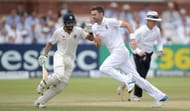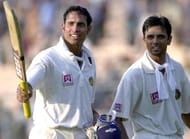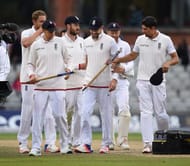“Leader, not follower”, read the Daily Mirror headline on 25th July 2016.
A day before, Alastair Cook opted not to enforce the follow-on despite a massive 391 run lead in the first innings. That too after bowling Pakistan out for a meagre 198 runs on day 3 of the second test at Old Trafford.
The decision straightaway created a divide in the cricketing circles. The move surprised many including Pakistan coach Mickey Arthur who was fully expecting Pakistan to be batting again immediately.
Michael Vaughan, the former England captain, was “absolutely staggered” by the decision who found it a waste of time, especially given the unpredictable Manchester weather. Shane Warne, the usual Cook critic, termed it as a “Surprising decision”. On the other hand, England assistant coach Paul Farbrace was in full support of Cook’s decision to not enforce the follow-on.
The unenforced follow-on, I must mention, added a bit of a spice to the game that was otherwise heading for a mundane finish. A possible English collapse or a gritty 10-hour innings by a Pakistan batsman or some blessings from rain gods would have made things pretty interesting.
But it wasn’t to be. Not only did England, who scored almost a run a ball 173 in the second innings, not collapse, but Pakistan collectively could not hold the fort for more than 70 overs and eventually lost the match by a whopping 330 runs on the fourth day.
Historically, there have been only three instances when the decision to enforce a follow-on has come back to haunt the enforcers. Australia was the victim on all three occasions: Sydney-1894 and Headingley-1981 versus England and, still fresh in the memory, Kolkata-2001 versus India.
So why is it then that the captains are hesitant to enforce the follow-on? It’s time to ponder.
To wear out the bowlers of the opposition
India played the first test at Trent Bridge, Nottingham on the English tour of July 2014. Though it was a draw, this test, according to many, set up the famous victory at Lord’s test that started four days later.
India batted a total of 284 overs, 161 overs in the first innings and 123 overs in the second, for about 20 hours. The draw was inevitable. But instead of giving England any chance to bat in the second innings, India kept on batting as much as possible to severely wear out the English bowlers.
So much so that Alastair Cook, who impersonated legendary Bob Willis during that spell much to the amusement of spectators, had to bring himself on to bowl. With little time to recover, and due to the brilliant overall performance by India, England lost the next test by 95 runs at Lord’s giving India its first win in 28 years at this venue.
As much as it is important to save your own bowlers the strategy has become to wear out the opposition’s bowlers. Thus, when England saw the opportunity, they grabbed it by not enforcing the follow-on.
The game is being played as much on the field as off it, isn’t it?
To rest own bowlers
With money comes greed. Professional Cricketers, especially in the Big 3 – India, Australia and England, are supposed to play incessantly throughout the year in various formats. The body can only take so much.
MS Dhoni has been vocal about poor scheduling and had once, accepting the notion that the associates should get high-quality matches, mentioned that “associates can play with other countries, not India”, citing the reason that IPL and Champions League are already crunching India’s schedule.
AB de Villiers too had concerns about the schedules and was rumoured to be on the verge of the test retirement. In such a dire scenario, test captains now a days, opt for a safer option of cutting down the bowlers’ workload as much and as necessary as possible.
In the hindsight, considering the fact that Anderson and Stokes, who injured himself again in Pakistan’s second innings, were coming back from injuries, Cook’s decision to not enforce the follow-on does not seem so irrational.
To crush the morale of the opposition
Cricket, and sport, in general, is a psychological phenomenon. Morale, much like momentum, has more impact in the game than visible to the naked eye.
Over the years, we have seen time and again that one great spell, one special innings or one great partnership has the ability to crush the confidence of the opposition.
Take the famous example of historic 2001 Kolkata test match. Australia came into this test with 16 consecutive test wins behind them and 1 up in the current series already with a comprehensive win in Mumbai in the first test match. Not to mention Aussies were playing their best squad ever. Team’s confidence was high and so was the morale.
But then, after being asked to follow-on, VVS Laxman and Rahul Dravid contrived one of the best rescue acts ever in the test cricket. The Aussies, those legendary Aussies with best bowling attack in the world, could not take a wicket all day.
It did a hefty damage to them psychologically. Australia looked baffled thereafter, rushed even. They could easily have played for a draw but they didn’t, and the rest is history.
England’s attempt at batting in the second innings looked more an attempt to punch Pakistan psychologically after latter’s famous win and upbeat celebrations at the Lord’s.
To avoid pressure in the fourth innings
The pitch starts deteriorating from the word go in a 5-day test match and is at the peak of its deterioration in the last; generally the fourth innings played on an average 4th or 5th Day.
The bounce becomes variable and unpredictable, the ball spins and misbehaves the most. With decent bowling attack, even 200 becomes a tricky target to chase in the fourth innings on a worsening pitch.
This adds to the pressure of the team batting last. After all, you are just a few misbehaving deliveries away from making inroads. Traditionally, the pressure has accounted to brain fade, irrational tactics, false shots, and inexplicable decisions even.
Nobody wants to be in that situation. Even those who opt to bowl first in a test match after winning the toss don’t want to be in that situation. Teams want to bat on the pitch that is still good for batting and fourth innings is definitely not that time.
Thus, whenever possible, to avoid pressure in the fourth innings, teams do not enforce the follow-on, but bat instead to get the pitch in worst possible condition to bowl the opposition out.
To surprise the opposition
They say “At any time in a test match, do exactly what the captain of the opposition doesn’t want or expect you to do at that very moment”.
A test match is like a game of chess. You make a move and wait for the opponent to make his while secretly hoping for that one move he shouldn’t make. And then there are surprises you are not ready for.
If the opposition wants you to declare, pile on. If they are looking to waste time, declare early. If they are looking to score quickly, spread the field. If they are playing safe, attack.
And if the opposition expects to follow-on, surprise them by asking not to, if it suits the team’s purpose. Owing to the fact that Cricket is being played as much in the dressing rooms as on the field, most teams have plans for everything, well, except for surprises.
Based on Arthur’s comments it can be concluded that Pakistan was looking to bat again immediately. But England surprised them by asking not to. In the field, Pakistan kept on leaking runs and England eventually scored run a ball for 30 overs.
In a situation where Pakistan were supposed to stem the run flow, waste the time, and hope for bad weather, they leaked profusely. There was no plan. Surprises do that.
Follow IPL Auction 2025 Live Updates, News & Biddings at Sportskeeda. Get the fastest updates on Mega-Auction and cricket news






